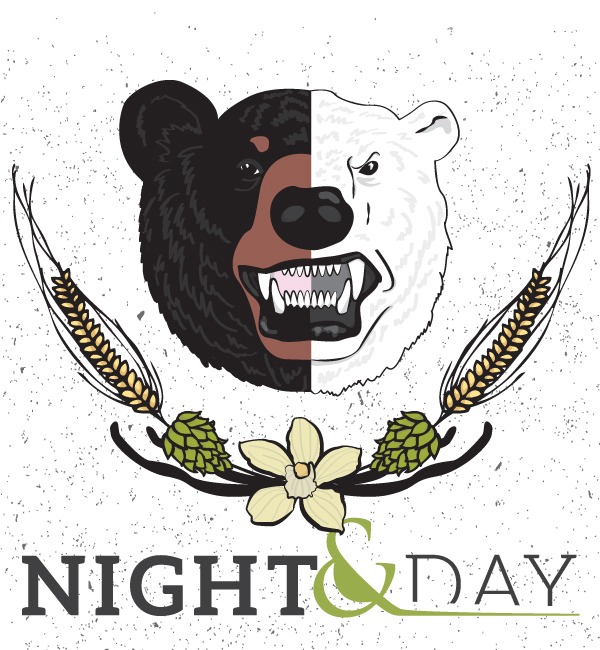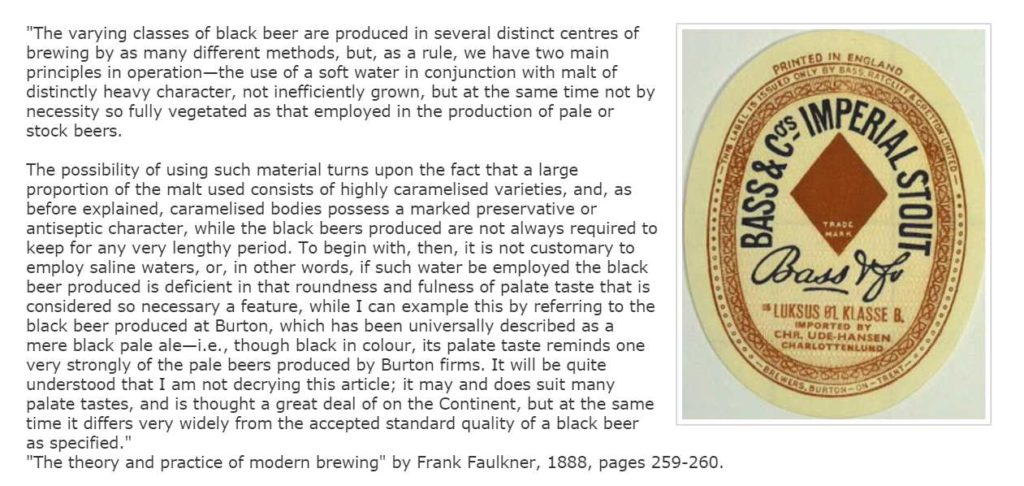(Editor’s Note: Kicking off our new series “Squinting at Two Goblets: Similar Beer Styles and How to Tell the Difference” — Post #1, Spy vs. Spy: IPA vs. Black IPA)
Dead Ringers (Except They Look Nothing Alike)
 Today we’ve got two of our favorite styles to look at, head-to-head — IPA vs. black IPA. By the way, the style of black IPA goes by six or more names — Cascadian Dark Ale, Indian Dark Ale, American-style Black Ale, etc. It’s a regional thing. But to help speed things along, we’ll refer to it as just “IBA.”
Today we’ve got two of our favorite styles to look at, head-to-head — IPA vs. black IPA. By the way, the style of black IPA goes by six or more names — Cascadian Dark Ale, Indian Dark Ale, American-style Black Ale, etc. It’s a regional thing. But to help speed things along, we’ll refer to it as just “IBA.”
Visually of course there’s no mistaking one for the other, the one being, well, black. But you’ll hear even knowledgeable people say they’re the same, other than the color. Blindfold your average craft beer drinker and have them taste an IBA; most will think it’s just a straight-up IPA.
So then how come both the Brewer’s Association (BA) Style Guidelines and the Beer Judge Certification Program (BJCP) have both given IBA its own official style category, distinct from IPA? Why do Pacific Northwesterners take as fighting words the notion that these two styles taste “basically the same”?
This controversy may have simmered down compared to the more recently inflamed debate over the “session IPA.” The trend there is to pooh-pooh the session IPA as just a gimmick — an IPA Lite – cooked up to bring more newbies into the craft beer market.
But, hold on. As they’ve done with the IBA, both the BJCP and the BA have given the session IPA an official seat at the style-guidelines table. Plus, plenty of serious craft drinkers wholly welcome session beers with their lower ABV because, hell, who doesn’t want to drink good beer all day long?
For this post we’ll just stick with the IBA question. Is it just a gimmick or is it different enough from IPA to warrant a separate style category?
Black Does Not Mean Burnt
Everyone can agree the IBA is black, at least. So let’s start by asking how an IPA could be made so dark, in the first place.
To make a dark beer brewers turn to “specialty” grain. Adding a small amount of darker, roasted grain to the base malt imparts, among other things, color. In fact brewers of IBA’s add the same specialty grain, such as roasted barley or black malt, that give stouts and porters their color. But specialty grain also gives stouts and porters other signature qualities — fuller body, sweetness, and especially coffee or dark chocolate bitterness.
That of course begs the question of how roasted grain can make an IBA black without leaving roast bitterness and creating a hoppy stout or hoppy porter. But that’s a separate blog post. For now let’s keep with the question at hand: Is an IBA merely an IPA that’s black?
Our blindfolded testers seem to think so. They don’t detect roast qualities, at all. Yes, some IBA’s can come quite roasty, especially those with higher alcohol by volume (ABV). But those are the exceptions. Listen to the classic version as described in the 2015 BA Style Guidelines:
. . . High astringency and high degree of burnt roast malt should be absent. Hop flavor is medium-high, with fruity, floral, herbal or other hop flavor from hops of all origins contributing. Hop bitterness is medium-high to high. Body is medium . . .
So IPA and IBA are officially the same?
No. As the definition continues, we get features that definitely distinguish the IBA from the classic IPA:
Medium caramel malt and dark roasted malt flavors are evident.
The BJCP Guidelines go even further, singling out other roast qualities in the IBA:
Medium-high to very high hop bitterness, although dark malts may contribute to the perceived bitterness . . . and can optionally have low caramel or toffee flavors. Dark malt flavors are low to medium-low; restrained chocolate or coffee flavors may be present, but the roasted notes should not be intense, ashy, or burnt, and should not clash with the hops. . . .
Granted, each mention of dark roast comes chaperoned by uptight, stingy qualifiers and conditionals – may contribute, can optionally have, may be present, restrained chocolate or coffee — which reduces all that talk of coffee and chocolate to mere whispers and rumors. Still, coffee, chocolate, in an IPA!
In their “Overall Impression” the BJCP sums it up well, that this beer does have the “hop-forward balance and flavor characteristics of an American IPA, only darker in color…”
. . . [b]ut without strongly roasted or burnt flavors. The flavor of darker malts is gentle and supportive, not a major flavor component.
It’s Not Where You’re from That Matters. Oh, Wait. It Is!
Although the first rule for an IBA is to be hop-forward, so far in this post, all we’ve talked about is roasted grain. Roasted grain brings color. Roasted grain brings flavor. Roasted grain this, roasted grain that.
Well, this next section is all about the hops. In particular, hop origins.
Virtually by definition, IBA’s use American hops. The BJCP Guidelines call for American hops, only. It’s true the BA Guidelines leave it open to “hops of all origins.” But try finding an IBA not brewed with American hops. It’s a challenge.
The bulk of American hops have been developed and grown by producers in “Cascadia” — that part of the Pacific Northwest bounded loosely by the Cascade Mountain Range, from Northern California up through British Columbia, and including parts of Idaho. Denizens of the region claim the IBA as their regional innovation. They call it the CDA, the Cascadian Dark Ale.
We’re talking all American hops, all the time. Think Columbus, Centennial, Citra, Chinook, Cascade, just to name some of the biggies. So IBA’s are made with “the Four C’s” — not Noble hops, not English, not Oceania — and also with newer American varietals, such as the uber-bitter hybrid Warrior. Other than Cascade, these all sport brash, high-alpha acid content of up to 17%.
The IPA, on the other hand, has more latitude to include hops of other origins. This goes far in explaining the two faces of IPA: “East Coast” / “West Coast.”
When someone says “East Coast IPA” we often think “malty IPA.” And that’s not wrong. East Coast IPA’s do often have a grain-centric facet to them, often adding specialty grain to the malt bill, which deepens the color and adds sweetness.
But we should also consider the hops factor. Many East Coast IPAs come across as European-influenced, i.e., mellower, earthier. Their recipes commonly include low-alpha, less-bitter, non-American hops. English hops Fuggles or Goldings, for instance, with their lower alpha acid content (4%-6%) come across as earthy — woody, grassy, musky.
Contrast that with the sharp citrus or intense pine of the American hops listed above, with their brash, high-alpha acid content of 9% to 17%. When someone says “West Coast” IPA? That’s easy. Same as IBA above, if not more so: Cascadia. American. In your face.
Two Styles: Young and Old. No, everything is old.
In Colonial times the British shipped pale ale to their colonies in India where it was too hot to brew beer. To keep the beer from spoiling on its six-month journey, it helped to boost the hops as a preservative. Hence, the name India Pale Ale.
I’ve known that story for years. The East India Company, the British empire, blah, blah. But honestly I didn’t know if that meant 1870 or 1903 or 1780. It was 1780. Or thereabouts.
It makes sense that refrigeration and pasteurization would bring on the demise of the IPA. merican craft brewers resurrected the style in the mid-1970s. Witness the birth of the American IPA.
Seems pretty straightforward. IPA, 18th Century. IBA, 21st Century. But some say a black, hoppy, not-very-roasty beer existed hundreds of years ago.
In his beer blog, Shut Up About Barclay Perkins, British beer critic Ron Pattinson makes the controversial claim that the English were drinking IBA’s 200 years ago.
Pattinson says,
“I’m coming to the conclusion that there’s nothing new in the brewing world. Look a bit more deeply and you’ll find most of the ‘innovations’ of the last 20 years are nothing of the sort. They’ve all been done before. Take Black IPA. When was the first one brewed? 2008? 2003? 1995? Perhaps a little earlier . . .”
The earliest proof Pattinson has found so far isn’t 200 years old. But it’s pretty old. It’s from a book (1888) by an academic or industry analyst who studied the British brewing of the day — and black beer, in particular. The book specifically references the breweries of Burton-on-Trent, such as Bass & Cos. Here’s a screenshot from Pattinson’s blog where he supplies a long quote from the book.
In that passage the writer refers to a hoppy black beer of that era that was loved as much as the “pale ale” of the time. And he specifically meant hoppy black beer distinct from porters and stouts.
So perhaps the IBA came about earlier than we thought.
We’ve brought back an old favorite — a black IPA called Night & Day IBA This was our December 2013 winner — Everything great about the style and then some, with the sweetness of added vanilla bringing out the subtle cocoa and roast of the specialty malts. Pick up a four-pack in stores, now!
Check out our October 2015 winner, No Stout About It! Order NOW! (ships mid-December).

